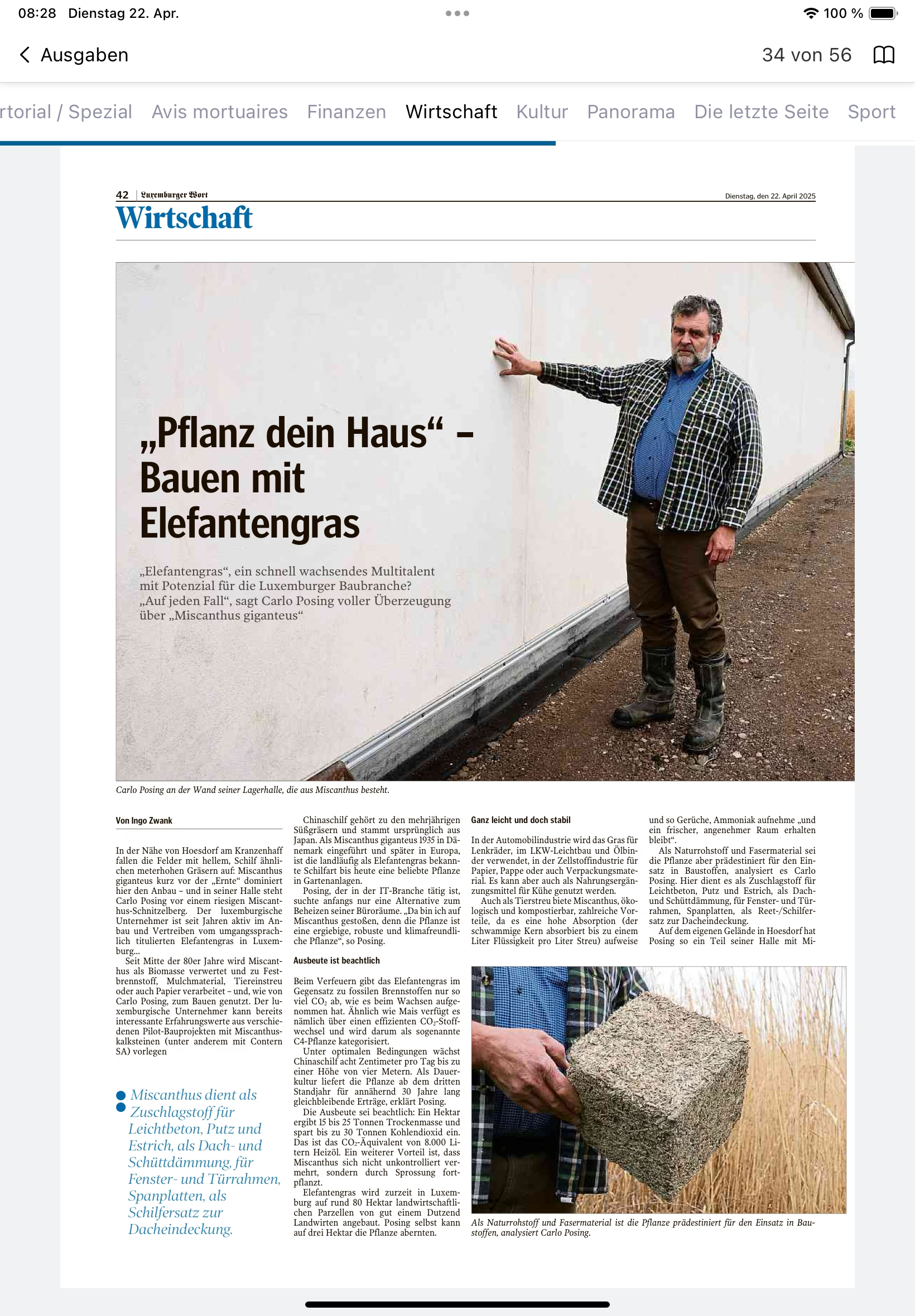
“Plant your house” – Building with Elephant Grass
Author :
Ingo Zwank
“Elephant grass,” a fast-growing multi-talented plant with potential for Luxembourg’s construction industry? “Absolutely,” says Carlo Posing with conviction about Miscanthus giganteus.
Carlo Posing stands next to the Miscanthus wall of his warehouse.
Just before “harvest,” the bright reed-like grasses dominate the landscape at Kranzenhaff near Hoesdorf: Miscanthus giganteus. Inside his warehouse, Carlo Posing stands in front of a huge mountain of Miscanthus chips. The Luxembourgish entrepreneur has been involved for years in the cultivation and marketing of the plant – also known as elephant grass – in Luxembourg.
Since the mid-1980s, Miscanthus has been used in the field of biomass: converted into solid fuel, mulch, animal bedding, or even paper – and, as in Carlo Posing’s case, in construction. He has already gained valuable experience through various pilot construction projects using Miscanthus-lime bricks (including with Contern SA).
Use of Miscanthus
Additive in lightweight concrete, plaster, and screed
Roof and loose-fill insulation
Window and door frames
Chipboards
Thatch substitute for roofing
Originally from Japan, Miscanthus is a perennial grass introduced in Denmark in 1935 and later cultivated in many European countries. Today, the plant – commonly known as elephant grass – is also valued in landscaping and gardening.
Posing, who originally worked in IT, was initially just looking for an alternative to heat his office. “That’s how I came across Miscanthus – a productive, robust, and climate-friendly plant,” he explains.
High yield
Unlike fossil fuels, burning Miscanthus only releases as much CO₂ as it absorbed during growth. Like corn, it has an efficient CO₂ metabolism and is a so-called C4 plant.
Under ideal conditions, the grass can grow eight centimeters per day and reach up to four meters in height. As a perennial crop, Miscanthus delivers regular yields from the third year onward – for nearly 30 years, says Posing. The yield is impressive: one hectare delivers 15 to 25 tons of dry matter and saves up to 30 tons of CO₂ – equivalent to 8,000 liters of heating oil. A major advantage: Miscanthus does not spread invasively but propagates through sprouting.
In Luxembourg, around 80 hectares are currently cultivated by about a dozen farmers. Posing himself harvests from three hectares.
Lightweight and stable
In the automotive sector, elephant grass is used in steering wheels, lightweight truck panels, and oil binders. In the pulp industry, it is used for paper, cardboard, and packaging. It is also suitable as a feed additive for cattle.
As bedding, Miscanthus offers numerous ecological benefits. It is compostable and has high absorbency (its sponge-like core can absorb up to one liter of liquid per liter of bedding), helping to neutralize odors and ammonia and keeping barns fresh.
“As a natural raw and fiber material, the plant is perfect for construction,” Posing analyzes.
He used it to build part of his warehouse in Hoesdorf. Other buildings in the Greater Region were also constructed with it.
Miscanthus impresses as a biological building material, not only due to its rapid growth and availability, but also because of its porosity. The plant tissue contains air pockets that make it ideal for insulation.
Posing has been researching ecological construction with Miscanthus for 20 years. When combined with water and lime, Miscanthus chips become “green concrete” with convincing properties.
Used in insulation boards, bio-concrete, and bioplastics, this ecological solution is sustainable and high-performing. Posing has already completed several buildings in Luxembourg (e.g., in Lorentzweiler and Ettelbruck), demonstrating the advantages of ecological concrete over conventional materials.
“Even the flooding in Ettelbruck caused no problems for these buildings,” Posing proudly reports.
To achieve the best results, the Miscanthus chips must be pre-treated with a hydrophobic binding agent such as lime. This prevents the pores from filling with water and losing their insulating effect.
The mixture can be applied as a “spray plaster” – even a two-centimeter layer achieves excellent insulation values, as proven by scientific studies.
Perennial cultivation for ~30 years
Miscanthus delivers high biomass yields for up to 30 years. Resembling reeds, it grows up to four meters tall and currently covers about 80 hectares in Luxembourg.
Politics has also taken an interest in elephant grass. In January 2025, Minister of Agriculture Martine Hansen welcomed her counterpart from North Rhine-Westphalia, Ina Scharrenbach (Minister of Home Affairs, Municipal Affairs, Building and Digitalization), for a meeting.
Accompanied by Prof. Ralph Pude (Chair of Renewable Resources at the University of Bonn), Scharrenbach visited Luxembourg. Carlo Posing also took part in the exchange. Prof. Pude and other researchers have long studied Miscanthus.
Topics included cultivation and marketing in Luxembourg, use as a building material, circular economy, bio-based materials, practical applications, and current challenges.
Minister Hansen sees potential in elephant grass as a way to diversify agriculture. Together with Economy Minister Lex Delles, she supports efforts to increase production and demand through pilot projects and to reduce administrative obstacles – a path Posing describes as necessary and meaningful.
Wind and erosion resistant
Miscanthus brings additional environmental advantages. It suppresses weeds and protects crops. Its resistance to wind and erosion, along with high water retention, reduces evaporation during heat waves.
Miscanthus decomposes naturally and enriches the soil with minerals, says Posing, observing one of his fields – often frequented by wild animals such as deer and wild boar.
It is considered a dry, stable, high-performance fuel, with constant quality and reliable supply.
“Thanks to its properties, it’s ideal for use in grate-fired boilers, ensuring efficient and clean combustion,” says Posing.
Used as fuel
The material is suitable for diverse energy needs – for private households, community heating, or large industrial plants. By choosing Miscanthus, companies support ambitious regional projects and promote the energy transition with renewable, ecological fuels.
However, communicating these benefits is not always easy.
“Agriculture and industry must work together,” emphasizes Posing, pointing to the bioeconomy – a sustainable economic model that uses biological resources such as plants, animals, and microorganisms.
Even during production, attention must be paid to climate, soil, and biodiversity protection.
“Functioning ecosystems are the foundation of the bioeconomy – and Miscanthus provides the best conditions,” says Posing.
But everything must be approved and certified, he stresses – because skepticism still exists toward innovation. That’s why Posing wants to address concerns and build trust in elephant grass – especially with the help of “LUGA – Luxembourg Urban Gardening.


